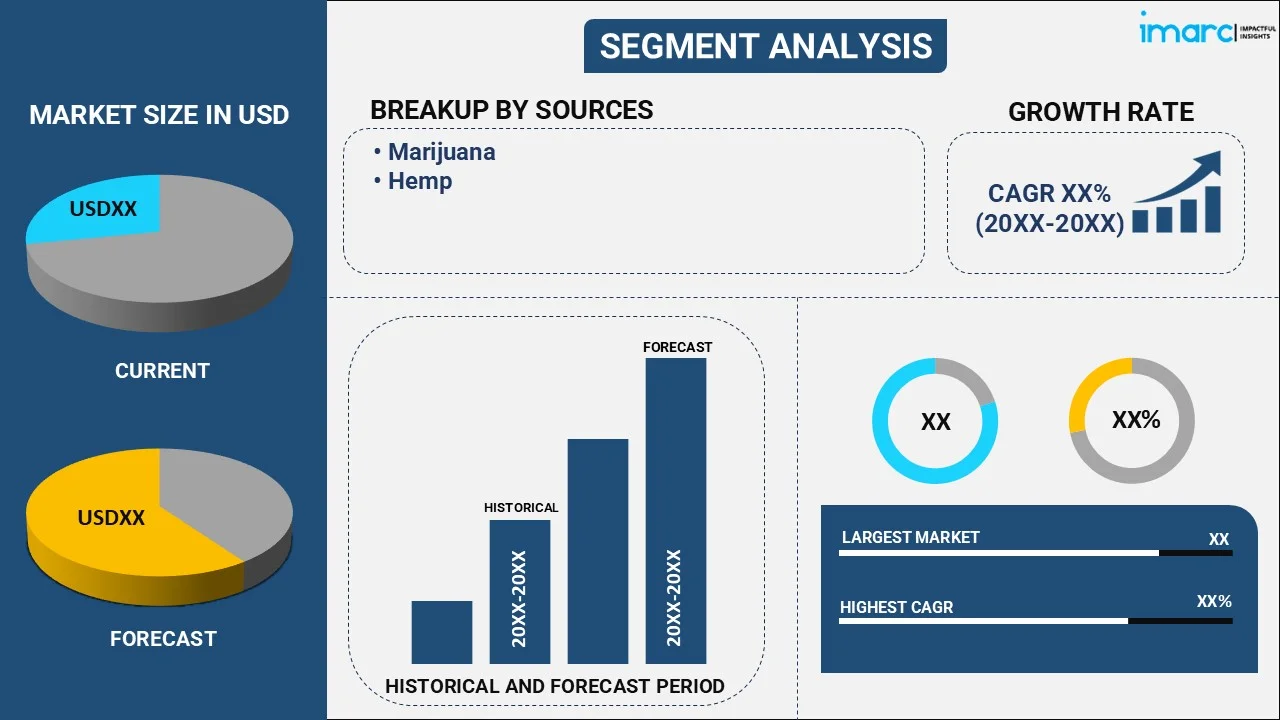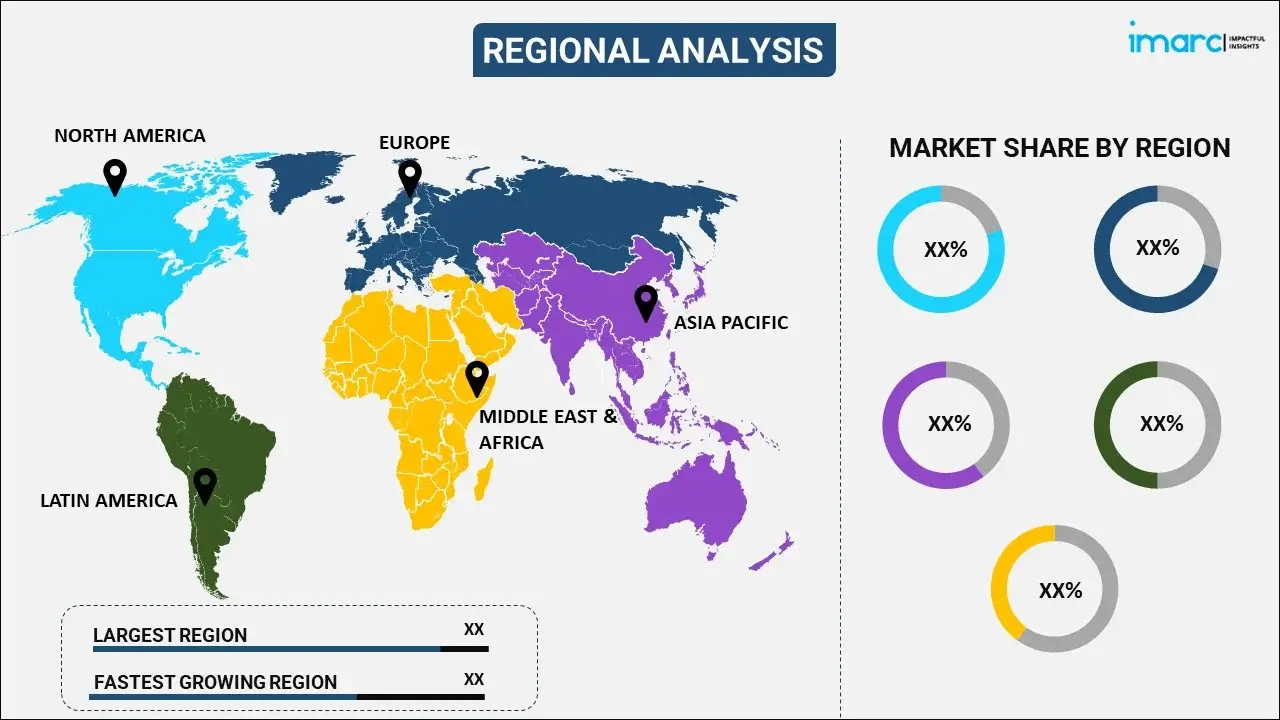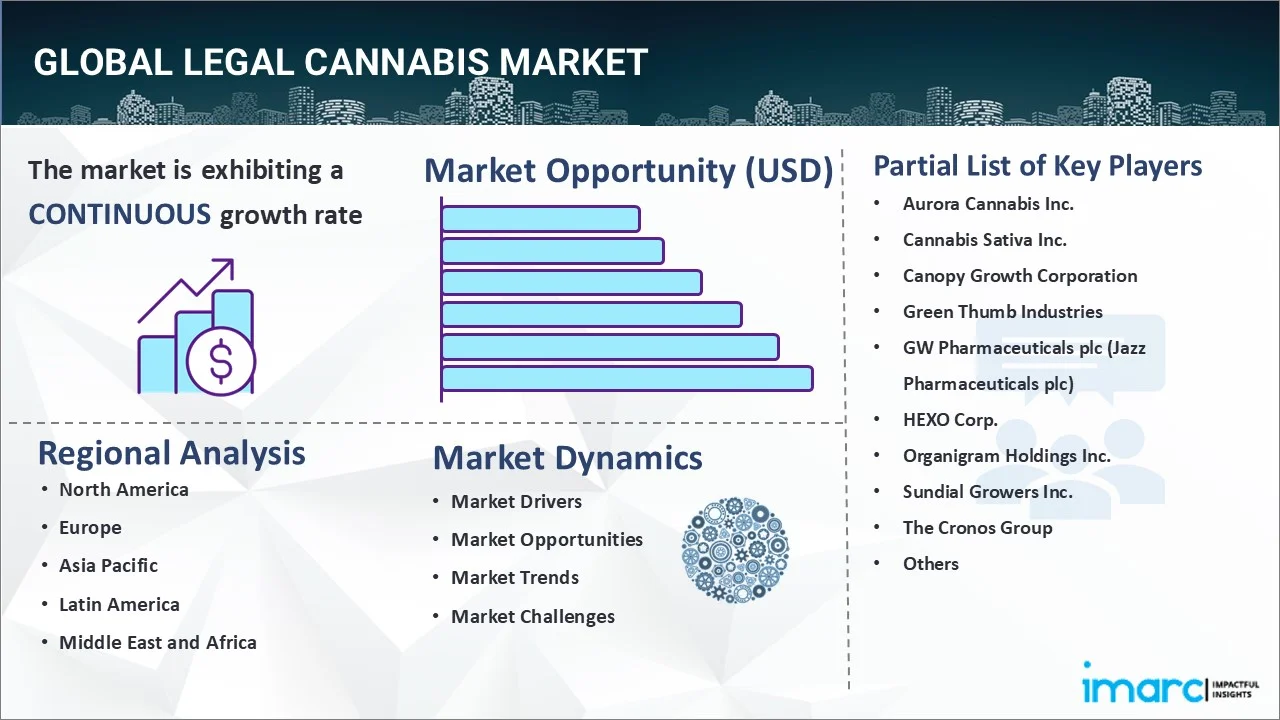
Legal Cannabis Market Report by Source (Marijuana, Hemp), Derivatives (Cannabidiol (CBD), Tetrahydrocannabinol (THC)), Distribution Channel (Recreational Stores, Pharmacies, Online Stores, and Others), End User (Medical Use, Recreational Use, Industrial Use), and Region 2025-2033
Legal Cannabis Market Size:
The global legal cannabis market size reached USD 31.9 Billion in 2024. Looking forward, IMARC Group expects the market to reach USD 158.4 Billion by 2033, exhibiting a growth rate (CAGR) of 19.5% during 2025-2033. The market is primarily driven by the constant regulatory changes, growing societal acceptance of the product globally, increasing medical applications, growing product diversification, shifting consumer preferences, extensive research and development (R&D) activities, and significant technological advancements.
|
Report Attribute
|
Key Statistics
|
|---|---|
|
Base Year
|
2024 |
|
Forecast Years
|
2025-2033
|
|
Historical Years
|
2019-2024
|
| Market Size in 2024 | USD 31.9 Billion |
| Market Forecast in 2033 | USD 158.4 Billion |
| Market Growth Rate (2025-2033) | 19.5% |
Legal Cannabis Market Analysis:
- Major Market Drivers: Global legalization laws are changing and opening up new areas for cannabis cultivation, distribution, and use, which is growing the legal cannabis market. In addition, consumers are looking for alternatives for both medical and recreational uses, which is fueling legal cannabis market demand as a result of growing social acceptance and changing attitudes regarding cannabis, thereby creating a positive legal cannabis market overview.
- Key Market Trends: In response to changing consumer preferences, the legal cannabis sector is seeing a rise in the variety of items it offers, such as beverages, health products, and edibles. Furthermore, advancements in product delivery systems, extraction processes, and cultivation strategies are changing the industry and legal cannabis market growth, efficiency, and quality.
- Geographical Trends: With a big consumer base, well-established infrastructure, and regulatory frameworks that support business expansion, North America holds the largest legal cannabis market share, due to the broad legalization of cannabis in Canada and several US states. Furthermore, Europe is emerging as the second-largest market with growing legalization efforts in nations, such as Germany, the Netherlands, and Spain. This growth is being driven by expanding medical cannabis programs, growing acceptance, and regulatory reforms.
- Competitive Landscape: Some of the major market players in the legal cannabis industry include Aurora Cannabis Inc., Cannabis Sativa Inc., Canopy Growth Corporation, Green Thumb Industries, GW Pharmaceuticals plc (Jazz Pharmaceutical plc), HEXO Corp., Organigram Holdings Inc., Sundial Growers Inc., The Cronos Group, The Green Organic Dutchman Holdings Ltd., The Scotts Mircale-Gro company, Tilray, and VIVO Cannabis Inc. among many others.
- Challenges and Opportunities: For those involved in the industry, regulatory obstacles and regionally disparate legal frameworks act as obstacles. Opportunities encompass broadening the range of products offered, venturing into untapped regions, and carrying out extensive investigations to discover supplementary medical uses, thus securing the future of legal cannabis market.
Legal Cannabis Market Trends:
Changing Legal Landscape and Acceptance
The legalization of cannabis for both medical and recreational use in a number of nations and jurisdictions has been a major factor positively influencing the legal cannabis market outlook. The shifting positions of governments on cannabis are creating new markets and commercial opportunities. As per a report published by IMARC Group, in 2018, Canada became the first of the G7 nations to fully legalize cannabis for recreational use, setting a precedent for other countries. This shift in the law encourages market expansion and lessens the stigma attached to cannabis use, which raises consumer acceptance.
Increasing Medical Applications and Research
Another significant factor is the growing acknowledgement of the therapeutic advantages of cannabis. The extensive research about the medical use of cannabinoids CBD and THC in particular, has grown drastically, which has eventually led to the increasing uses of legal cannabis. Numerous medical disorders, such as multiple sclerosis, epilepsy, and chronic pain, are being treated using cannabis. According to the World Health Organization (WHO), it is estimated that over 1.8 million people have multiple sclerosis (MS) worldwide. People of all ages can be affected; however, it is more common in young adults and in females. It can improve or stabilize by being treated with medicines early in the course of the disease and treatments will be different for each person depending on the severity of the disease and symptoms. As more clinical research demonstrates its effectiveness, medicinal cannabis gains credibility as a viable substitute for conventional medications.
Economic Impact and Taxation
Through taxes, the legal cannabis industry provides governments with significant revenue streams that finance healthcare, education, and other services. Programs to combat drug abuse and promote economic development are also funded in part by tax income. Additionally, the legal cannabis industry promotes employment growth in a number of industries, including distribution, retail, cultivation, and ancillary services, such as packaging, marketing, and consultancy. Especially in areas where the industry is flourishing, this increase in employment boosts local economies and lowers unemployment rates. As per the latest legal cannabis statistics report by National Organization for the Reform of Marijuana Laws (NORML), the cannabis industry created an average of 280 new jobs per day in 2021.
Legal Cannabis Market Segmentation:
IMARC Group provides an analysis of the key trends in each segment of the market, along with forecasts at the global, and regional levels for 2025-2033. Our report has categorized the market based on source, derivatives, distribution channel, and end user.
Breakup by Source:

- Marijuana
- Hemp
Marijuana accounts for the majority of the market share
The report has provided a detailed breakup and analysis of the market based on the source. This includes marijuana and hemp. According to the report, marijuana represented the largest segment.
The marijuana segment majorly possesses strains of a plant called Cannabis Sativa, which is an annual plant with upright stems and palmate leaves with 5-7 linear-lanceolate leaflets that can grow up to 5 m in height. The rising legalization of cannabis for recreational and medicinal purposes in different locations has led to a notable growth in this industry. Along with the medical uses, marijuana has multiple recreational uses, which are fueled by the euphoric properties of the drug. The adoption of marijuana for the treatment of nausea, pain, and numerous neurological disorders is constantly rising.
Breakup by Derivatives:
- Cannabidiol (CBD)
- Tetrahydrocannabinol (THC)
Cannabidiol (CBD) holds the largest share of the industry
A detailed breakup and analysis of the market based on the derivatives have also been provided in the report. This includes cannabidiol (CBD) and tetrahydrocannabinol (THC). According to the report, cannabidiol (CBD) accounted for the largest market share.
Cannabidiol is one of the most important substances in the cannabis plant, well-known for its non-psychoactive properties. It is highly adopted by individuals seeking health advantages of cannabis without the euphoria brought on by THC. The growing awareness about the possible medicinal uses of CBD is one of the major factors driving the legal cannabis market revenue. Numerous ailments, such as anxiety, discomfort, inflammation, and epilepsy, are treated with CBD. It appeals to a wide range of individuals, from those seeking natural cures to medical experts using it in treatment regimens.
Breakup by Distribution Channel:
- Recreational Stores
- Pharmacies
- Online Stores
- Others
Pharmacies represents the leading market segment
The report has provided a detailed breakup and analysis of the market based on the distribution channel. This includes recreational stores, pharmacies, online stores, and others. According to the report, pharmacies represented the largest segment.
Pharmacies provide a reliable, regulated setting for the distribution of medicinal marijuana products, guaranteeing compliance with regulations and quality control. According to National Institutes of Health (NIH), various countries utilize pharmacies and pharmacists to dispense medical cannabis. Consumers are more confident as a result, especially patients looking to use medicinal cannabis for a variety of ailments. Additionally, pharmacies are well-suited to dispense medicinal cannabis in addition to conventional drugs as they already have the infrastructure and experience handling pharmaceutical items. The seamless patient access and consultation made possible by this integration improves the quality of healthcare as a whole. Pharmaceutical companies are also entering into partnerships in order to expand their product portfolio.
Breakup by End User:
- Medical Use
- Recreational Use
- Industrial Use
Medical use exhibits a clear dominance in the market
A detailed breakup and analysis of the market based on the end user have also been provided in the report. This includes medical use, recreational use, and industrial use. According to the report, medical use accounted for the largest market share.
As per the National Institutes of Health (NIH) report, in 1996, with the passage of the Compassionate Use Act, California became the first state to legalize the access to and use of botanical cannabis for medical purposes under the supervision of a doctor. In recent years, the medical cannabis market has grown and gained popularity significantly. The market for medicinal cannabis products has been fuelled by patients looking for alternative therapies for a range of medical problems. Products made especially to treat conditions such as multiple sclerosis, anxiety, epilepsy, and chronic pain are included in this category. Patients who seek holistic approaches to manage their health find medical cannabis to be an appropriate alternative to traditional medicines.
Breakup by Region:

- North America
- Asia-Pacific
- Europe
- Latin America
- Middle East and Africa
North America leads the market, accounting for the largest legal cannabis market share
The report has also provided a comprehensive analysis of all the major regional markets, which include North America, Europe, Asia-Pacific, Latin America, and the Middle East and Africa. According to the report, North America represents the largest regional market for legal cannabis.
North America, particularly the United States and Canada hold maximum number of shares in the market. State-by-state legalization of cannabis for both medical and recreational purposes has resulted in a notable shift in the United States. On account of this, there is a sizable domestic market and a significant demand for cannabis-related items. As per a report published on IMARC, Canada legalized cannabis for recreational use at the federal level in 2018, creating a market that is well-regulated. The well-established cannabis business of the region, which encompasses retail, processing, and production, benefits from a well-established supply network. It continues to draw significant investment, promoting the creation of new products and innovations.
Competitive Landscape:
- The market research report has also provided a comprehensive analysis of the competitive landscape in the market. Detailed profiles of all major companies have also been provided. Some of the major market players in the legal cannabis industry include Aurora Cannabis Inc., Cannabis Sativa Inc., Canopy Growth Corporation, Green Thumb Industries, GW Pharmaceuticals plc (Jazz Pharmaceutical plc), HEXO Corp., Organigram Holdings Inc., Sundial Growers Inc., The Cronos Group, The Green Organic Dutchman Holdings Ltd., The Scotts Mircale-Gro company, Tilray, and VIVO Cannabis Inc. among many others.
(Please note that this is only a partial list of the key players, and the complete list is provided in the report.)
- The major players in the market are extensively pursuing plans to maintain their positions and profit from the expansion of the sector. In response to changing consumer tastes, these businesses are concentrating on diversifying their product lines to include a wide variety of cannabis and CBD products. They are also spending money on research and development (R&D) to improve farming practices, create cutting-edge delivery systems, and guarantee the safety and quality of their products. In order to expand their market share and reach new areas, many are also involved in partnerships, mergers, and acquisitions. These major players are positioning themselves to navigate obstacles and take advantage of new opportunities in this dynamic business as the regulatory landscape continues to change. In April 2023, Hello Juice & Smoothie, a juice and smoothie store in the United States, partnered with the Beleaf Co. to introduce a new product line of CBD-infused juice shots.
Legal Cannabis Market News:
- May 2022: Canopy Growth Corporation, a major player in the legal cannabis market has expanded its product portfolio. It launched two new flavors for its cannabis-infused carbonated drinks, grape and orange.
- Green Thumb Industries (GTI) has expanded its footprints across the United States. It is opening up more dispensaries and increasing its manufacturing capacity in order to cater to the growing demand for cannabis products.
Legal Cannabis Market Report Scope:
| Report Features | Details |
|---|---|
| Base Year of the Analysis | 2024 |
| Historical Period | 2019-2024 |
| Forecast Period | 2025-2033 |
| Units | Billion USD |
| Scope of the Report | Exploration of Historical Trends and Market Outlook, Industry Catalysts and Challenges, Segment-Wise Historical and Predictive Market Assessment:
|
| Sources Covered | Marijuana, Hemp |
| Derivatives Covered | Cannabidiol (CBD), Tetrahydrocannabinol (THC) |
| Distribution Channels Covered | Recreational Stores, Pharmacies, Online Stores, Others |
| End Users Covered | Medical Use, Recreational Use, Industrial Use |
| Regions Covered | Asia Pacific, Europe, North America, Latin America, Middle East and Africa |
| Companies Covered | Aurora Cannabis Inc., Cannabis Sativa Inc., Canopy Growth Corporation, Green Thumb Industries, GW Pharmaceuticals plc (Jazz Pharmaceuticals plc), HEXO Corp., Organigram Holdings Inc., Sundial Growers Inc., The Cronos Group, The Green Organic Dutchman Holdings Ltd., The Scotts Miracle-Gro Company, Tilray, VIVO Cannabis Inc., etc. |
| Customization Scope | 10% Free Customization |
| Post-Sale Analyst Support | 10-12 Weeks |
| Delivery Format | PDF and Excel through Email (We can also provide the editable version of the report in PPT/Word format on special request) |
Key Benefits for Stakeholders:
- IMARC’s industry report offers a comprehensive quantitative analysis of various market segments, historical and current market trends, market forecasts, and dynamics of the legal cannabis market from 2019-2033.
- The research report provides the latest information on the market drivers, challenges, and opportunities in the global legal cannabis market.
- The study maps the leading, as well as the fastest-growing, regional markets.
- Porter's five forces analysis assists stakeholders in assessing the impact of new entrants, competitive rivalry, supplier power, buyer power, and the threat of substitution. It helps stakeholders to analyze the level of competition within the legal cannabis industry and its attractiveness.
- The competitive landscape allows stakeholders to understand their competitive environment and provides insight into the current positions of key players in the market.
Key Questions Answered in This Report
The legal cannabis market was valued at USD 31.9 Billion in 2024.
We expect the global legal cannabis market to exhibit a CAGR of 19.5% during 2025-2033.
The growing adoption of medical cannabis in combination with other therapies to combat the side-effects and increase the effectiveness of the treatment for various chronical ailments, such as chronic pain, cancer, and social anxiety, is primarily driving the global legal cannabis market.
The sudden outbreak of the COVID-19 pandemic had led to the rising focus on drug discovery and clinical trials for novel vaccines against the coronavirus infection, resulting in the postponement of numerous R&D activities for cannabis-based drugs across several nations.
Based on the source, the global legal cannabis market has been segmented into marijuana and hemp, where marijuana currently accounts for the majority of the total market share.
Based on the derivatives, the global legal cannabis market can be divided into Cannabidiol (CBD) and Tetrahydrocannabinol (THC). Currently, Cannabidiol (CBD) exhibits a clear dominance in the market.
Based on the distribution channel, the global legal cannabis market has been segregated into recreational stores, pharmacies, online stores, and others. Among these, pharmacies currently hold the largest market share.
Based on the end user, the global legal cannabis market can be bifurcated into medical use, recreational use, and industrial use. Currently, medical use exhibits a clear dominance in the market.
On a regional level, the market has been classified into North America, Asia-Pacific, Europe, Latin America, and Middle East and Africa, where North America currently dominates the global market.
Some of the major players in the global legal cannabis market include Aurora Cannabis Inc., Cannabis Sativa Inc., Canopy Growth Corporation, Green Thumb Industries, GW Pharmaceuticals plc (Jazz Pharmaceuticals plc), HEXO Corp., Organigram Holdings Inc., Sundial Growers Inc., The Cronos Group, The Green Organic Dutchman Holdings Ltd., The Scotts Miracle-Gro Company, Tilray, and VIVO Cannabis Inc.
Need more help?
- Speak to our experienced analysts for insights on the current market scenarios.
- Include additional segments and countries to customize the report as per your requirement.
- Gain an unparalleled competitive advantage in your domain by understanding how to utilize the report and positively impacting your operations and revenue.
- For further assistance, please connect with our analysts.

 Request Customization
Request Customization
 Speak to an Analyst
Speak to an Analyst
 Request Brochure
Request Brochure
 Inquire Before Buying
Inquire Before Buying




.webp)




.webp)












